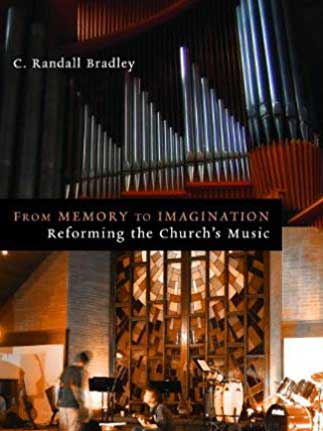
From Memory to Imagination: Reforming the Church’s Music
C. Randall Bradley
Eerdmans, 2012; 251 pages
![]()
Imagine getting a call from your realtor one afternoon. He’s excited to show you a new listing that he thinks could be a great buy. Crown molding, new windows, stainless steel appliances, fresh paint, lots of space, and it’s in a great neighborhood. And the best part, he says triumphantly, is that it’s well below your budget.
So you pull up in the driveway, realtor in tow, and on first appearance it seems he’s right. The house clearly shows pride of ownership, even from the street. You walk up the front steps together, open the door, and… the first thing you see is a deep crevice in the tile floor, running the entire length of the house, and wide enough to swallow a small dog.
You wouldn’t buy the house, of course. By all means, you could appreciate the crown molding, Perhaps you’d write down some decorating ideas for your own house. But you’d steer a wide berth. And you certainly wouldn’t recommend it to anyone as a viable investment.
That’s how I felt reading Bradley’s From Memory to Imagination. Bradley is an experienced author and speaker, and a well-respected professor of church music (some of you might know his book From Postlude to Prelude: Music Ministry’s Other Six Days, which I remember reading in grad school). From Memory to Imagination is part of the Calvin Institute of Christian Worship Liturgical Studies Series. But within the first 50 pages, Bradley establishes himself as a fully-convinced theological liberal, drinking deeply from the well of postmodernism. A brief selection of quotes should suffice:
When we’re not willing to move beyond memories from the past, we risk not experiencing new forms of worship, new ways to view God (2… well, that didn’t take long).
In order to experience the freshness and newness of God, we must be continually moving past memory towards imagination (2).
While we do our best to keep God’s “Godness” in perspective, we are incapable of worshiping God objectively, and to think we can is idolatrous, since we are incapable of understanding God in ways that transcend our own biases and contexts (4).
Instead of allowing our memory to launch us toward imagining and basking in the vastness of God, we let our memory become myopic, and we spend our lives experiencing the same God-place many times (6).
Reforming the church’s music will require the best that all of us can offer. No one will have all the answers, but within all of us there will be some hunches and some fresh ideas about where the wind of the Spirit is blowing (11).
We are on a journey, and those who insist they know the way have already programmed their lives—they can put their lives on automatic pilot. They will be spared the potential for getting lost. Unfortunately, they will also miss the likelihood of misreading the map and the possibility of discovering new relationships while taking a detour, and they will be the lesser for it (13, and I’m not even sure what this means).
The church’s music, the institutions it embodies, the ideals it upholds, and the legends and stories that surround it are a multi-layered myth that the church and its musicians have served without pausing to question its origins, its contextual truth, or its relevance to the future (20).
Ultimately, all power within the church should reside with the people, in the voice of the community both locally and globally (28).
Preaching can’t survive as it is, because it’s based on power (33)… because it lacks opportunity for input (34)… because a sermon is a monologue (34)… because it’s not multi-sensory (35)… because it’s male-dominated (36).
Can I stop now? In the first 50 pages, which form the “foundation” of the book’s assertions, the Scriptures are never cited once. In fact, the word “Bible” or “Scripture” doesn’t even appear until page 50, and even then, it is dismissed with a wave of the hand. “The Bible can be read and perceived differently by different individuals and faith communities.” And “We must not use the Bible to camouflage our own preferences and opinions” (50). Bradley makes it clear that the musical “reformation” he’s advocating for is not merely stylistic or cultural, but structural.
We’re in a battle. And it’s not a battle for musical style, or traditions, or cultural preferences. It’s a battle for the authority of Scripture and the centrality of the exclusive gospel. Paul’s warning in Acts 20:30 rings true: “from among your own selves will arise men speaking twisted things, to draw away the disciples after them.”
I might make reference to several helpful aspects of Bradley’s book, such as the valuable historical overview of church music on pages 16-20, or his insightful suggestions in Chapter 10 on becoming multi-musical. But it’s all crown molding and new paint. There’s a huge crack in the foundation, friends. Don’t buy the house.
